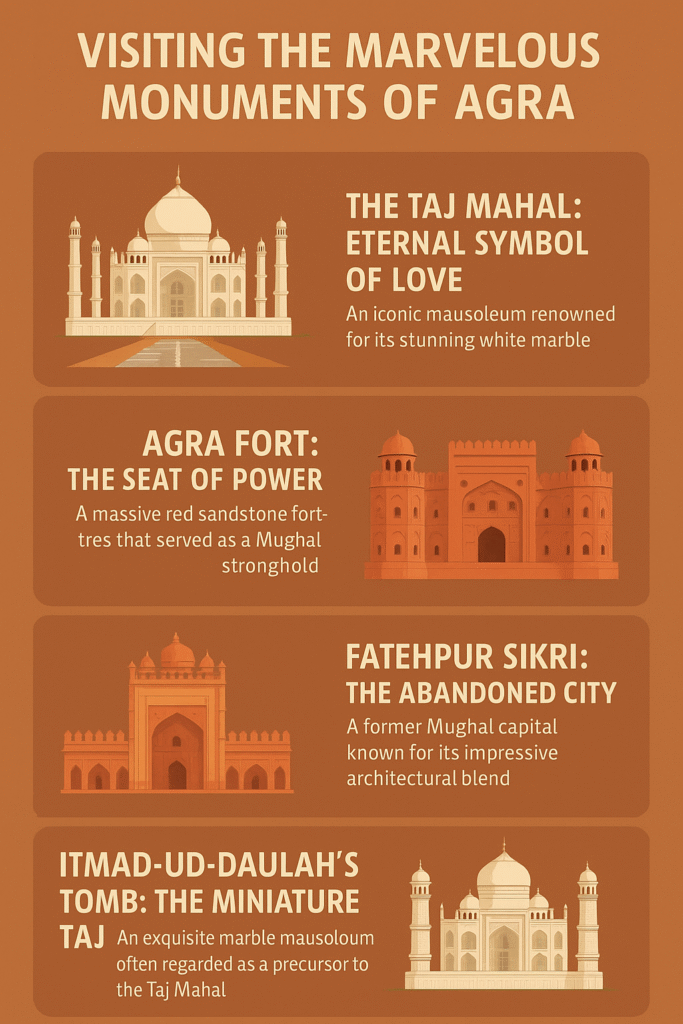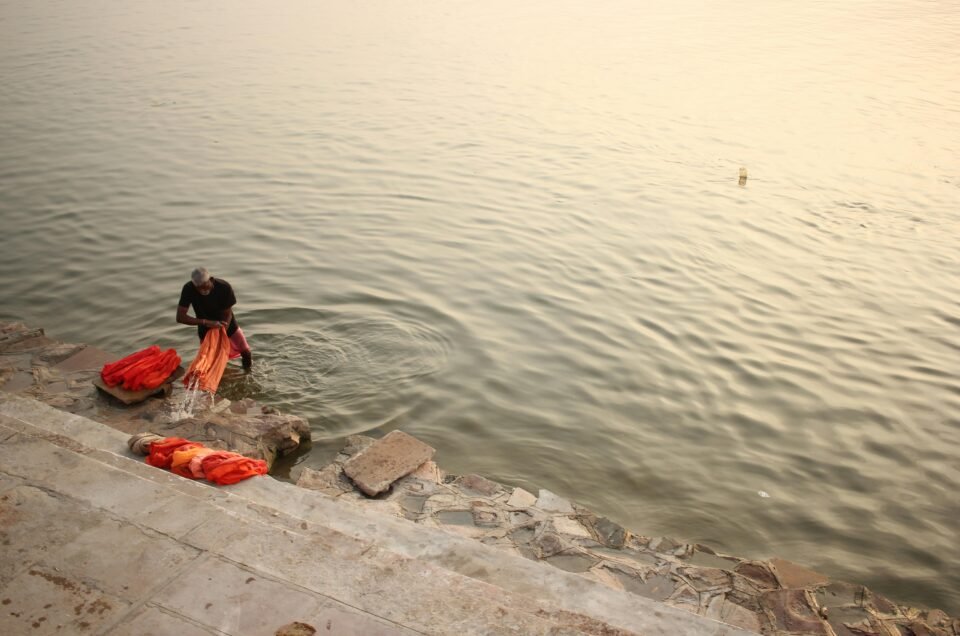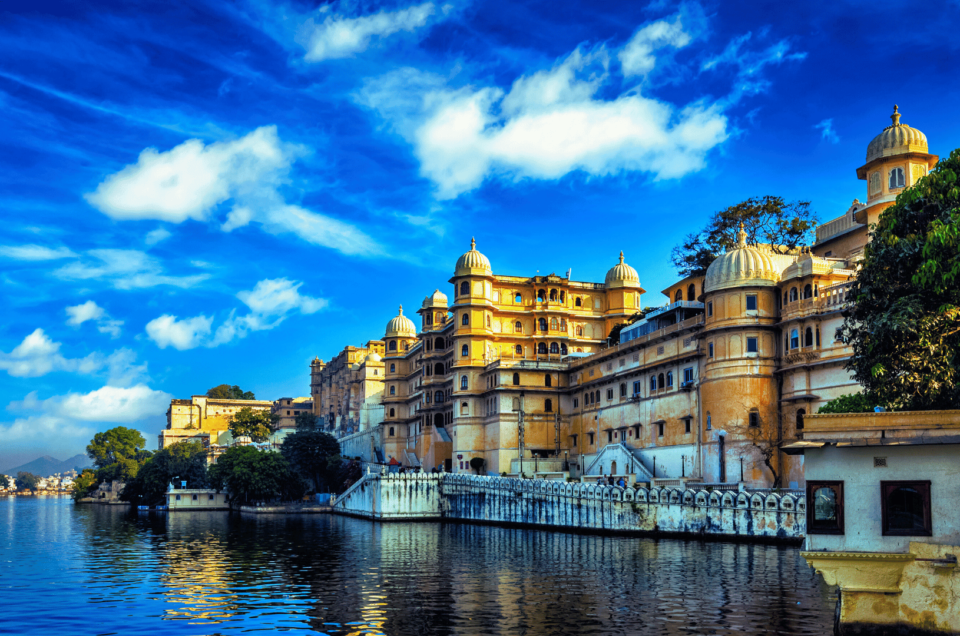Agra, the city which is famous for its love story that is still remembered through the ages and its luxurious past of emperors, is ranked among the top travel destinations of India. Situated by the Yamuna River, Agra is an ensemble of the Mughals’ legacy aesthetically through its monuments, colorful bazaars, and culturally diverse festivals. Agra Travel Guide is a must-have for the globetrotters who want to immerse themselves in the fascinating historical treasures, scenic wonders and creative talents of the Great Indian Plains.
The list of wonders that one can find in Agra from the world-famous Taj Mahal-a monument that stands for everlasting love, the mighty Agra Fort and the once-powerful FatehpurSikri, to the latest corner of the city, each of which speaks power & love through history. This Agra Travel Guide urges people to come to the city to discover the life, the essence, and the grandeur of this place that goes way beyond the Taj Mahal. Whatever be your inclination – art, history or just roaming – Agra is always there to offer you a series of mesmerizing moments that will be etched in your memory forever.
Agra: The City of Timeless Heritage
The historical charm of Agra is its perfect harmony of regal sophistication and cultural richness. The city is such that those who come to India to see the marvels of its architecture will be amazed by how these monuments are intimately associated with love, faith, and art.
| Aspect | Highlights | Significance |
| Founded By | Sultan Sikandar Lodi (1504) | Strategic military and trade hub |
| Famous Monuments | Taj Mahal, Agra Fort, FatehpurSikri | UNESCO World Heritage Sites |
| Location | Uttar Pradesh, India | On the Golden Triangle route |
| Best Time to Visit | October – March | Pleasant weather and festivals |
Not only heritage but also contrasts are what visitors to Agra city are fascinated with. It is a place where the past coexists visually with the present as one can find marble monuments that have stood for centuries next to the lively bazaars and century-old crafts.
A Heritage of Emperors
Today, Agra is best known as the city of the Taj Mahal, which in the 1500s was made the Mughal capital by Emperor Akbar during whose reign it became famous. His heirs, Jahangir and Shah Jahan, went beyond one simply preserving the city’s majesty, they also decorated it by erecting the Taj Mahal and Agra Fort, two of the world’s most astonishing architectural masterpieces.
Cultural and Artistic Influence
The powerful Mughals’ impact on the city, can still be felt, through arts, music, and food. Gorgeous and elaborate marble inlay work, known as pietra dura, and skillfully crafted leather good are the two most outstanding of the Agra’s handicrafts.

Visiting the Marvelous Monuments of Agra
Agra’s monuments represent the finest Mughal architecture each building states the empire’s ideas religion and craftsmanship – Agra Travel Guide.
The Taj Mahal: Eternal Symbol of Love
There is none like it. There is no grander tomb made of a beautiful white marble in the world, and perhaps there is no greater memorial for love than this ivory-white face on India’s skyline. Shah Jahan, a Mughal emperor, built the Taj Mahal to represent his undying love for his late wife, Mumtaz Mahal in the manner night changes color from the pinkish shade of dawn to golden during sunset. The balance, the mirror-like pool, the beautiful designs are the forming elements and create a masterpiece which is astonishing.
Agra Fort: The Seat of Power
Once constructed by Akbar in red sandstone, Agra Fort was the heart of the Mughal Empire’s administration. Besides the green and blue enameled tiles of the Diwan-i-Khas and Jahangir’s Palace, there are also palaces, mosques, and courtyards. The strength of the Mughal dynasty is retold by the fort’s huge layout and splendid entry points.
FatehpurSikri: The Abandoned City
Fatehpur Sikri is approximately 40 kilometers away from Agra. The ancient city is recognized for its harmony blending traditional Persian, Indian, and Islamic cultures, and is the only place on earth where such architecturally amazing buildings like Buland Darwaza and Jodha Bai’s palace have been found to exist intact. These are fascinating works.
Itmad-ud-Daulah’s Tomb: The Miniature Taj
In contrast, the “Miniature Taj” is often associated to the “Baby Taj”, the tomb of Emperor Jahangir’s wife Nur Jahan’s father. In essence, it is the first Mughal building created solely out of marble, hence the similarity in the Taj Mahal’s architecture.
Comparing Agra’s Must-See Attractions
Each Agra building represents a different aspect. It is an aspect of Mughal architecture.

- Taj Mahal has the highest popularity with 100 percent.
- Agra Fort is the second most popular with 85 percent.
- FatehpurSikri attracts 70 percent of visitors.
- Itmad-ud-Daulah’s Tomb has a popularity of 60 percent.
- MehtabBagh is the least popular with 50 percent.
Each of these monuments together symbolize the supreme historical past of North India’s emperors.
The fact that despite the passage of time people still hold affection to Taj Mahal, the strength that one can experience at Agra Fort, the magnificence of FatehpurSikri these three old places are the base of the amazing heritage circuit.
Agra Beyond the Monuments: Culture, Cuisine, and Crafts
Though Agra is most famous for the Taj Mahal, it has a much wider character and lifestyle as well.
Culinary Experiences
Agra’s food is typical Mughal Persian food, full of flavors and aroma.
- Petha: A native Agra sweet. It is made from ash gourd. It looks translucent.
- Mughlai Cuisine: Biryani, seekh kebabs, and mutton korma began inside royal Mughal kitchens.
- Street Food: Chaat exists as a popular item for street food. Jalebi and samosas are popular street food items too.
Art and Handicrafts
Agra is famous for:
- Marble Inlay Work is one of the main features. The amazing skills used in the Taj Mahal are the inspiration of it.
- Leather Goods: Top-quality leather is used to make leather bags, belts, and shoes of good quality.
- Zardozi embroidery: The metal thread decorations used for embroidery of local street stalls are offered.
Festivals and Cultural Events – Agra Travel Guide
Agra festivals show the city’s culture to people. They offer the best way to do so.Every February the Taj Mahotsav is an event of great delight with its celebrations of art, music, and crafts besides numerous other activities. The fair entertains and folk perform within the city since they stay within the city’s folklore and integrate into the city’s cultural life. Travel Tips and Itinerary Planning for Agra
When to Visit
The most suggested period to pay a visit to Agra is surely from October to March. The temperature is usually very friend during these months and is perfect for visiting other places. From April to June, one-day heat will be unbearable whereas the raining season will have heavy showers sometimes.
Suggested 2-Day Itinerary
- Day Morning Afternoon around Evening
- Day 1 Visit Taj Mahal at Agra Fort. See Mehtab Bagh’s sunset views.
- Day 2 Trip to Fatehpur Sikri. Itmad-ud-Daulah’s Tomb Local Market Shopping nearby.
Essential Travel Tips
- Wear modest clothing especially in religious areas.
- Certified guides lead tours to explore history.
- Purchase handicrafts from government-registered shops and establishments.
Accommodation Options
Agra has many five-star hotels or luxury hotels with a wonderful view of the Taj Mahal as well as cost-effective budget hotels. There are also a number of accommodations where you can stay with a view of the monument right from the hotel’s terrace, which adds to this love tale.
The Eternal Charm of Agra Travel Guide
Not just a place to visit, Agra represents a trip through time and culture that connects one’s senses with their feelings. The very air around its monuments carries stories of love and might, while the people preserve culture through the arts and gastronomy.
Book your journey with Luxury Rajasthan Tours for an amazing travelling experience and enjoy tour with so much fun and joy.













